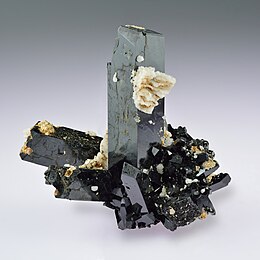Aegirine
| Aegirine | |
|---|---|
 Aegirine (dark) with minor feldspar (light) from Malawi | |
| General | |
| Category | Silicate mineral, pyroxene |
| Formula (repeating unit) | NaFe3+[Si2O6] |
| IMA symbol | Aeg[1] |
| Strunz classification | 9.DA.25 |
| Crystal system | Monoclinic |
| Crystal class | Prismatic (2/m) (same H-M symbol) |
| Space group | C2/c |
| Unit cell | a = 9.658, b = 8.795 c = 5.294 [Å], β = 107.42°; Z = 4 |
| Identification | |
| Formula mass | 231.00 g/mol |
| Color | Dark Green, Greenish Black |
| Crystal habit | Prismatic crystals may be in sprays of acicular crystals, fibrous, in radial concretions |
| Twinning | Simple and lamellar twinning common on {100} |
| Cleavage | Good on {110}, (110) ^ (110) ≈87°; parting on {100} |
| Fracture | Uneven |
| Tenacity | Brittle |
| Mohs scale hardness | 6 |
| Luster | Vitreous to slightly resinous |
| Streak | Yellowish-grey |
| Diaphaneity | Translucent to opaque |
| Specific gravity | 3.50–3.60 |
| Optical properties | Biaxial (−) |
| Refractive index | nα = 1.720 – 1.778 nβ = 1.740 – 1.819 nγ = 1.757 – 1.839 |
| Birefringence | δ = 0.037 – 0.061 |
| Pleochroism | X = emerald green, deep green; Y = grass-green, deep green, yellow; Z = brownish green, green, yellowish brown, yellow |
| 2V angle | Measured: 60° to 90°, Calculated: 68° to 84° |
| Dispersion | moderate to strong r > v |
| References | [2][3][4][5] |
Aegirine is a member of the clinopyroxene group of inosilicate minerals. It is the sodium endmember of the aegirine–augite series. It has the chemical formula NaFeSi2O6, in which the iron is present as the ion Fe3+. In the aegirine–augite series, the sodium is variably replaced by calcium with iron(II) and magnesium replacing the iron(III) to balance the charge. Aluminum also substitutes for the iron(III). Acmite is a fibrous green-colored variety.
Aegirine occurs as dark green monoclinic prismatic crystals. It has a glassy luster and perfect cleavage. Its Mohs hardness varies from 5 to 6 and its specific gravity is between 3.2 and 3.4.

This mineral commonly occurs in alkalic igneous rocks, nepheline syenites, carbonatites and pegmatites. It also appears in regionally metamorphosed schists, gneisses, and iron formations; in blueschist facies rocks, and from sodium metasomatism in granulites. It may occur as an authigenic mineral in shales and marls. It occurs in association with potassic feldspar, nepheline, riebeckite, arfvedsonite, aenigmatite, astrophyllite, catapleiite, eudialyte, serandite and apophyllite.[2]
Localities include Mont Saint-Hilaire, Quebec, Canada; Kongsberg, Norway; Narsarssuk, Greenland; Kola Peninsula, Russia; Magnet Cove, Arkansas, US; Kenya; Scotland and Nigeria.
The acmite variety was first described in 1821, at Kongsberg, Norway,[6] and the aegirine variety in 1835 for an occurrence in Rundemyr, Øvre Eiker, Buskerud, Norway. Aegirine was named after Ægir, the Norse god of the sea.[3] A synonym for the mineral is acmite (from Greek ἀκμή "point, edge") in reference to the typical pointed crystals.[7]
It is sometimes used as a gemstone.[8]
See also[edit]
References[edit]
- ^ Warr, L.N. (2021). "IMA–CNMNC approved mineral symbols". Mineralogical Magazine. 85 (3): 291–320. Bibcode:2021MinM...85..291W. doi:10.1180/mgm.2021.43. S2CID 235729616.
- ^ a b Handbook of Mineralogy
- ^ a b Mindat
- ^ Webmineral
- ^ Hurlbut, Cornelius S.; Klein, Cornelis, 1985, Manual of Mineralogy, 20th ed., ISBN 0-471-80580-7
- ^ Dana, James Dwight (1855) [1837]. Manual of Mineralogy (7th ed.). Philadelphia, PA: Durrie & Peck.
- ^ . Encyclopædia Britannica. Vol. 1 (11th ed.). 1911. p. 149.
- ^ Dictionary of Gems and Gemology By Mohsen Manutchehr-Danai p.5
